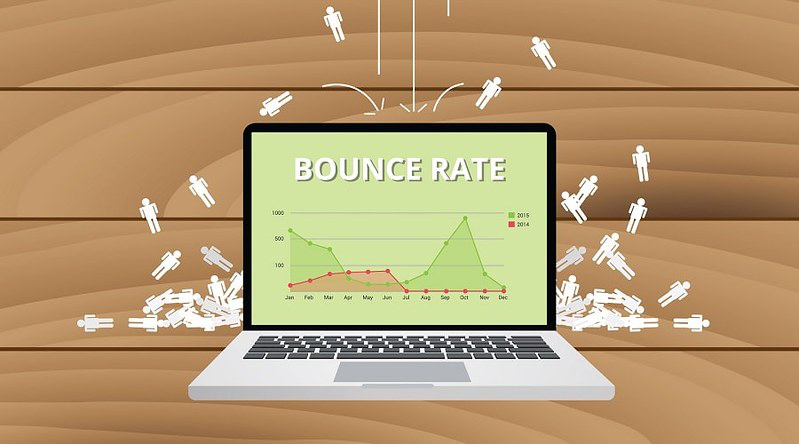Bounce Rate
“Why is my bounce rate so high?”
This common query echoes across different social news websites, online forums, and various social media platforms, likely even crossing your mind. In fact, it might be what led you to discover this article.
But fret not, there’s no such thing as a “perfect” bounce rate.
However, having an excessively high bounce rate isn’t desirable either.
Read on to discover the possible reasons behind your high bounce rate and learn practical tips to make your website more captivating and relatable to your audience.
What is bounce rate?
Bounce rate is a crucial metric in the field of search engine optimization (SEO) that measures the percentage of visitors who land on a webpage and then leave without interacting with any other page or element on the site. In other words, they “bounce” back to the search results or close the tab/window after viewing just one page. A high bounce rate can be an indicator that visitors are not finding what they are looking for or that the web page’s content is not engaging enough to keep them interested.

Why is Bounce Rate Important in SEO?
Search engines, like Google, consider bounce rate as one of the factors when evaluating a website’s user experience and overall quality. A high bounce rate suggests that your content might not be relevant or valuable to the users, which could negatively impact your site’s search engine rankings. On the other hand, a low bounce rate implies that visitors are finding value in your content and are more likely to engage further, which can be beneficial for SEO.
How to Address a High Bounce Rate
If you want to improve your site’s search engine rankings, then you must learn how to lower your bounce rate. Let’s take a look at some techniques that can significantly decrease your bounce rate.
Content Relevance and Quality
Analyze the pages with high bounce rates to identify potential issues with your content. Make sure that your content is relevant, informative, and matches your users’ search intent. Additionally, poorly written or outdated content can lead to higher bounce rates, so it’s vital that you update it regularly.
Page Load Speed
Slow-loading pages can frustrate visitors and increase bounce rates. Optimize your website’s performance to ensure that pages load quickly on both desktop and mobile devices. Compress large images, leverage browser caching, and use content delivery networks (CDNs) to enhance load times.
Mobile Optimization
With a significant portion of internet users accessing websites on mobile devices, it’s crucial to have a mobile-friendly website. A responsive design that adapts to different screen sizes will improve user experience and helps reduce bounce rates on mobile.
Clear Call-to-Action (CTA)
Make sure that each page has a clear and compelling CTA that drives visitors to take the desired action, whether it’s signing up for a newsletter, making a purchase, or exploring other relevant pages on your site.
User-Friendly Navigation
One effective way to remedy a high bounce rate is to ensure that your site’s navigation is intuitive and easy to use. People should be able to find the information they need without getting lost or confused. A well-structured site will encourage users to explore further thus reducing bounce rates.
External Link Quality
Check the external links that lead to your site. If visitors are coming from sources that are not relevant to your content, they may quickly leave, increasing your bounce rates. Remember, to focus on getting backlinks from authoritative and relevant websites.
Improve Meta Descriptions
An enticing and accurate meta description can improve click-through rates from search engine results pages (SERPs). When people see that your page meets their expectations, they are more likely to stay and explore further.
Keyword Targeting and Intent
Ensure that your content aligns with the keywords you are targeting. Analyze search queries and understand user intent to provide content that precisely match their needs.
A/B Testing
Perform A/B tests on different elements of your web pages, such as headlines, images, and CTA buttons, to see what resonates best with your audience and keeps them engaged.
Landing Page Optimization
For specific landing pages, such as those from ad campaigns, focus on ensuring alignment between the ad content and the landing page content. This consistency will reduce the likelihood of users bouncing back immediately.
Do note that bounce rate should be considered in context. Some pages, like blog posts or single-page informational content, may naturally have higher bounce rates. However, for transactional or conversion-focused pages, a high bounce rate could be a major concern.
By continuously monitoring bounce rates and implementing the above strategies, you can enhance user experience, engage your audience better, and ultimately boost your site’s search engine rankings through SEO.
You can also read about 301 redirect, backlinks, CRM, Google Analytics, Google Search Console, Inbound Marketing, Screaming Frog, ROI, Bounce Rate, CRO, Wordpress, Serprobot, Basic HTML, Skyscraper Technique, Mastery of Content Creation, Content Marketing Trends and many more topics in our knowledge hub.
